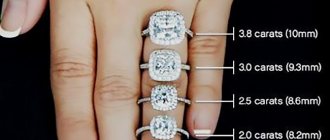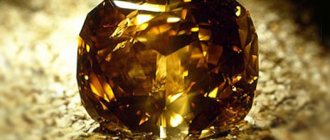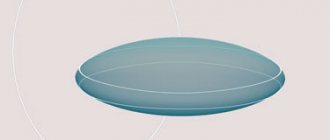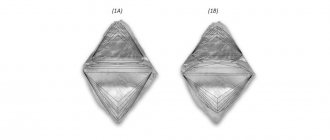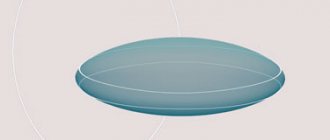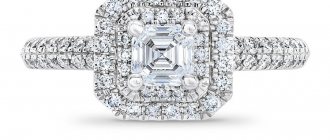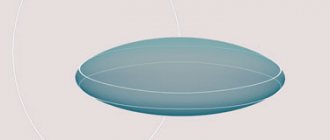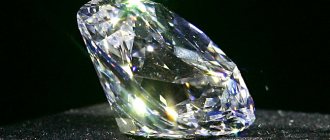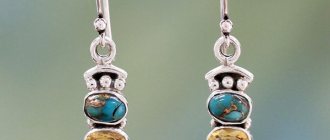General rules for cutting stones
Several of the first cutting techniques appeared in the 19th century; it was then that jewelers decided on the standards of the techniques. In addition, fantasy varieties appeared.
It depends on the type of cut:
- The cost of a diamond. Always a complex cut with a large number of facets will cost more than standard cutting methods.
- The appearance and brilliance of a diamond. With the help of cutting, you can hide the defects of the stone and its unevenness. But this can only be achieved if the jeweler is highly skilled.
Often, diamond cutting is done ineptly, then the stone is considered damaged and is sold cheaper. The edges should be smooth and refract light in such a way that, looking through the stone at the sun, you can see the rays from the edges directed to one point. In this case, the refracted ray has the colors of a rainbow.
The first geometric calculations were carried out by Marcel Tolkowsky: it was he who determined the parameters of an ideal round diamond, which is now a common process technique. Such a stone has 57 or occasionally 58 facets. This can be done by a jeweler using the following techniques: Tolkowsky, Johnson and Roech, Eppler and the Scandinavian diamond cut.
As a result, the diamond has the following parts:
- crown - the upper part of the stone with a platform;
- pavilion - cone-shaped lower part;
- calleta - the top of a stone;
- girdle - the part between the crown and the pavilion.
Moreover, jewelers calculate the parameters of each of them, and if they do not coincide with the standards, then the cut is incorrect. But such methods are used only in standard cases.
Modern processing
Cutting is the part of the diamond processing process that gives the stone its familiar appearance. Before cutting, a diamond may not seem so bright and beautiful. Therefore, the process should be led by an experienced jeweler in order to emphasize all the advantages of the stone and hide its shortcomings. As a result, we take into account:
- symmetry of edges;
- size of edges and their location;
- stone polishing.
These criteria affect the cost of the mineral. If we talk about the difference in price between two methods of cutting diamonds of the same shade and weight, then it reaches 30%.
Diamond elements
The most common method used to process diamonds is commercial cutting. There is also a fantasy technique, as a result of which stones acquire an unusual shape, but it is more complex and more expensive. And the usual commercial method also has its own subtypes that affect the cost.
There are types of cut “A”, “B” and “C”. They differ from each other in the loss of raw materials and the appearance of the diamond in the end. An “A” cut stone has ideal proportions, but there are large production losses. But the “B” and “C” cuts allow for inaccuracies in proportions, so the stone turns out to be stretched in length or height. Accordingly, it does not shine and play in the light as much. But only a jeweler can notice such irregularities, and a diamond will look just as beautiful in a piece of jewelry.
Each stone must have its own document, that is, a certificate, which indicates the type of cut of the stone. If it is type "A", the characteristics should be as follows:
| Pad size relative to diameter, % | 55–63 |
| Diamond height relative to diameter, % | 57–63 |
| The height of the girdle relative to the diameter, % | 1–2,5 |
If you purchased a stone in Russia, then there is a chance that the diamond cut will be of higher quality than that of minerals abroad. Because each country has its own standards, and the Russian Federation has more stringent ones.
The modern cutting method was invented and implemented by Marcel Tolkowsky. The first copy appeared in 1919. The essence of the cut is that light enters through the upper surface of the stone and is reflected from the lower edges. When reflected, rays of white light combine and turn into a rainbow. Therefore, now the method is recognized as classical and has certain parameters. Among the known and used methods today, the following are used:
- Tolkowski.
- Johnson and Roech.
- Eppler.
- Scandinavian diamond cut.
The stone often has 57 faces and is conventionally divided into the following parts:
- crown with platform;
- girdle;
- pavilion.
Types and classifications of cuts
There are situations when a jeweler comes across a diamond of an unusual shape. Then the fancy cut comes to the rescue
Common techniques:
- Stepped, in which the edges of the stone are parallel to the girdle and have a rectangular shape. Using this method, you can emphasize the purity of the stone.
- Modified - a fantasy option, which results in stones of different shapes.
- Mixed is the most popular technique after the round classical cut. People call her "Princess". It has a square shape with sharp corners and emphasizes the transparency of the stone and its shade. This stone looks like a pyramid. Since the lower part of the pavilion is quite massive, the entire play of light takes place there, which gives the mineral sophistication.
If we talk about the modified cut, it is popular due to its unusual shape, which is obtained in the end. With such products you can surprise others and express your individuality. These forms are also used in cases where it is necessary to display the purity of the stone as fully as possible.
Common fantasy forms
Round diamond
Of all the cut shapes, round diamonds are the most popular, perhaps due to their strong “play” and greater return of white light to the observer than other cuts. When creating a round cut, the yield from a diamond is significantly less than in the case of other cuts. This, along with the high popularity of round diamonds, are two main reasons for the relatively high cost of these stones.
The round cut sets the standard for other shapes and accounts for over 75% of all diamonds sold to date. This 57 (58)-sided shape consists of a crown (top), girdle (widest part) and pavilion (bottom). To achieve maximum play in a round diamond, certain proportions must be strictly maintained.
There are several types of cuts for the standard round stone shape.
Designations are recognized throughout the world :
- Type A. has an ideal cut in terms of the appearance of the stone. All parameters are taken into account. But at the same time, the method is uneconomical, and losses during the process amount to about 60% of the starting material. Accordingly, in stores, a cut stone according to this principle will be the most expensive. The area on the crown is formed by the intersection of squares.
- Type B. The stones are stretched in diameter or height, which affects their site. Rectangles intersect on it, not squares. Losses with this option are 48-55%.
- Type B. Minerals with poor symmetry, but the loss of raw materials is only 45%.
Of course, in addition to the price, this also affects the appearance of the stone. It won't play as much in the light. But at the same time, few non-professionals will be able to determine the type of cut.
The final cost depends on the type of disproportionality: in height, diameter or in all edges. Disadvantages of the cut can also be hidden by the setting of the stone, which should be made more massive.
Marquis
Marquise is a boat-shaped wedge cut. Awnings are often chosen by women who have an independent style. This elongated shape creates the effect of long and narrow fingers.
The cut dates back to the time of the Sun King, Louis XIV. The king, who wanted to marry the Marquise de Pompadour, ordered the creation of a diamond similar to the Marquise's smile. The cut looks impressive in solitaires, as well as surrounded by small diamonds.
Pear
Pear is a drop-shaped wedge cut. These attractive diamonds are often used in pendants and earrings. Many of the largest stones ever found were cut into pears. Both large and small diamonds are cut in the shape of a pear. A large single pear-shaped diamond set in a ring visually lengthens the fingers.
Oval
Oval is a wedge cut with an oval outline. More often, this form is used for cutting large diamonds for setting in rings, earrings and pendants. A large single oval-shaped diamond set in a ring visually lengthens the fingers.
Princess
Princess – wedge cut square or rectangular with sharp corners. The cut has a very good game and a high degree of brilliantness.
This relatively new cut with many sparkling facets is often used as single pieces in rings, earrings and pendants. Often the princess in rings is accompanied by trilliants on both sides. To increase the play of the stone, it is necessary to significantly increase the depth of the pavilion to 70-78%.
While most square and rectangular cuts cannot match the sparkle of a round diamond, the Princess was specifically designed to approximate the sparkle of a round diamond.
When purchasing a princess cut diamond piece, you need to ensure that the setting protects the four corners of the stone that are most susceptible to chipping.
Emerald
Emerald is a stepped rectangular cut with truncated corners and has an octagonal outline. A diamond cut with emerald can be absolutely magnificent. This cut has less play, but wider and brighter flashes of light. Refined and elegant, this shape is often used to set rings.
Due to the “openness” of the cut, cracks, low color and poor cut quality become noticeable even to the naked eye, so when purchasing an emerald-shaped diamond, it is extremely important to pay attention to the quality of the stone.
The emerald cut diamond cut is not as traditional as the round cut and not as fashionable as the princess cut, which makes the price of emerald cut diamonds not as high (compared to other cuts). In recent years, square emerald cut diamonds have become more popular.
Asher
The Asscher cut is a type of emerald cut that has a square shape and more tiers. The usher allows the wearer to look elegant and majestic.
This Art Deco cut style combines old-fashioned charm with modern cutting technology to create a dazzling diamond. Ashers with equal length and width are preferred. This ratio should not exceed 1.1:1.
Radiant
This is a square or rectangular wedge cut with an octagonal outline. Radiant combines the elegance of emerald with brilliant and the play of a round brilliant. To achieve greater play of the stone, it is necessary to increase the depth of the pavilion during cutting, which in turn entails an increase in the weight of the stone.
The radiant cut is more often used for cutting single large stones. The radiant form can enhance the color of fancy colored diamonds.
Diamond cutting
Quite often, with reference to legends and traditions, the idea is advanced that diamonds were cut thousands of years ago. This is not true. Even back in the 14th century. In India, it was believed that in order to preserve the magical and mystical properties of a diamond, one should not in any way change the shape of the diamond given to it by nature. It is now generally accepted that the first attempts to polish diamond crystals were made at the beginning of the 14th century, but not in India, but in Europe. The uneven surfaces of the crystal seemed to be leveled, and thus a higher transparency of the stone was achieved. At the same time, the tops of the crystal became sharper, and therefore the first processed diamonds were called “sharp stone” or “point stone”. Basically, these were regular octahedra with sharp vertices and this was the first type of basic cut, which dates back to the 14th century. Such diamonds appeared as jewelry in the Middle Ages and remained very popular during the Renaissance. True cutting, which changes the shape of the original diamond, first appeared in Europe in the early 16th century. The change in shape was minimal, and the type of cut was called “plate cut” (Table Stone or Table Cat). It is believed that this type of cutting appeared simultaneously with the invention of the process of roughing (setting the shape) and polishing (i.e. removing excess weight from the diamond). Moreover, the platform was not only from above, but often also from below. This additional bottom edge is called the “callet”.Flat cutting concerned mainly octahedral-shaped crystals. Many of the first diamonds cut in this way had a callet the size of half the top platform. This cut came to Europe from the east and was known as Indian. Subsequently, most of these diamonds were recut. In diamond production, the flat cut dominated throughout the 16th and early 17th centuries, as its geometry was believed to enhance the magical properties of the diamond. Over time, cutting with a platform was improved. The first improvement is the addition of four additional narrow facets to the four natural facets at the top and bottom of the diamond. As the peeling process changed, the shape of the table cut became more complex.
Gradually, the old simple cut diamond took on a round shape, which became known as the “round simple cut” or “round partial cut.”
By the middle of the 17th century, the “pointed” and “platform” cuts practically ceased to be used in the processing of rough diamonds into polished diamonds. The round shape of the cut became predominant. The simple round cut became the forerunner of the modern brilliant (faceted) cut.
In the history of the development of diamond cutting, rose cutting occupies a special place. A rose cut diamond has a flat bottom and a domed top. In the 15th century, rose-cut diamonds became quite widespread.
Rose cutting was very popular among the masters of Amsterdam and Antwerp, especially in the 18th and 19th centuries. The Amsterdam or Dutch rose cut differed from the Antwerp cut by its higher top and sharper dome. These diamonds have three levels (parts): the top (dome or crown), usually consisting of six facets; the middle one, also consisting of six encircling edges and six paired wedges, and a flat base (bottom). The height of the diamond was usually half the diameter of the base, and the diameter of the crown was three quarters of the diameter of the base.
In the 19th century, double rose cut diamonds were very popular, set in earrings and used to make watch fobs before they were worn on the wrist. The double rose cut is also ancient, as at least two historical diamonds, the Florence and the Sancy, were cut this way.
Later, rose cutting was improved in the direction of giving the diamond different shapes and increasing the number of facets applied.
One of the earliest cuts involving the application of additional facets to a natural octahedral-shaped diamond in the history of the development of cutting art was called the “Mazarin” cut, named after the French Cardinal Mazarin. His collection consisted of 16 large diamonds, including such famous ones as Sancy (55 carats) and Mirror of Portugal (30 carats). It is known that he bequeathed his collection to the French crown with the condition that they would go down in history as the Mazarin diamonds. The Mazarin cut diamonds known to us were made in the shape of a cushion with 17 facets applied to the pavilion, including the culet.
In those days, such cutting was rare and required a lot of labor. Therefore, only very wealthy people could afford to purchase a diamond of this cut, among whom was a French cardinal.
The Mazarin cut and other types of cuts that existed at that time were performed with a relatively large culet. This was necessary so that the light passing through the diamond from above would be reflected from it and thereby increase the brilliance and play of the diamond. Subsequently, when the height of the pavilion was reduced and thereby achieved the effect of total internal reflection, the culet turned into a sharp spike, i.e. has practically disappeared. The masters moved closer and closer to what we now call the ideal or classic diamond cut.
Since in the 17th century and early 18th century diamond processing was a fairly developed craft, it is unlikely that it is fair to attribute the invention of the diamond cut to any one master. However, the Venetian master Vincenzo Peruzzi entered the history of diamond art, after whom one of the types of cuts, rightfully considered diamond, was named. The shape of the lower part of the diamond increasingly resembled a cone onto which the edges were applied. It is this shape that cut diamonds came to be called diamonds.
A significant increase in the production of diamonds occurred in the 17th century, and in the 18th century the recutting of diamonds of old shapes and organ types began. This was partly due to the development and introduction of new diamond processing technologies, and partly due to the fact that flat-cut diamonds went out of fashion and all interest in them was lost. Making a round diamond from an octahedral diamond required a lot of work, and fashion demanded round diamonds.
The discovery of Brazilian deposits gave a new impetus to the further improvement of diamond cutting. One type of this cut is called the Brazilian cut. This cut is known as the triple cut and is now called the “antique cut.” The shape of the diamond resembles a pillow, has 33 facets in the upper part, including the platform, and 25 facets in the lower part, including the culet. There were 58 facets in total, that is, as many as a modern diamond has.
Without a doubt, the discovery of the diamond cut contributed to a more complete disclosure of the aesthetic properties of the diamond and its beauty in the unity of brilliance and play of light. And although the cut was then relatively far from the modern ideal, it immediately won general recognition and a leading position in the diamond market. However, back in the mid-19th century, many believed that the diamond cut was just another fashion trend that would soon pass, and the rose cut would far outlast it. But beauty prevailed, and in the subsequent years of the 19th and 20th centuries, many rose-cut diamonds were recut into brilliant cuts, despite the catastrophic loss of weight of the stone.
